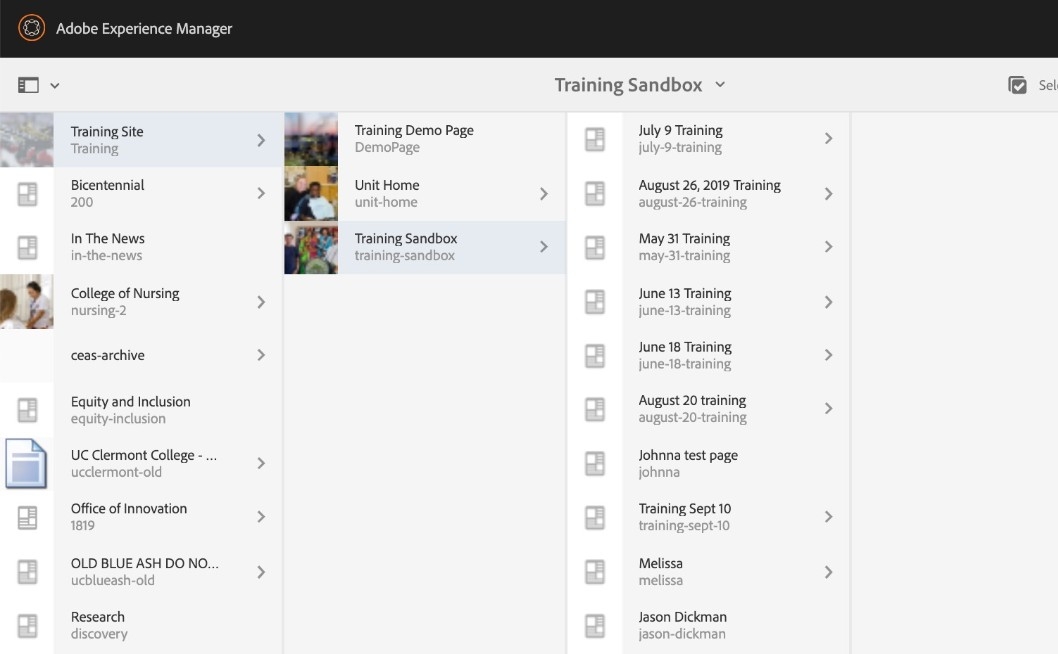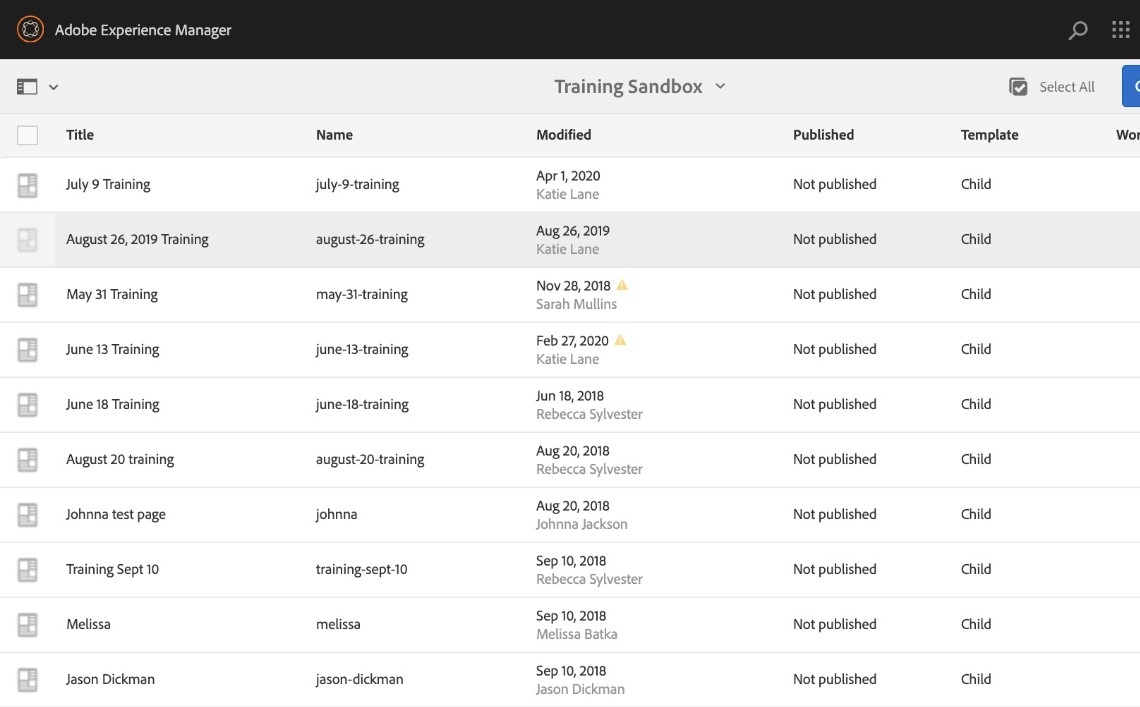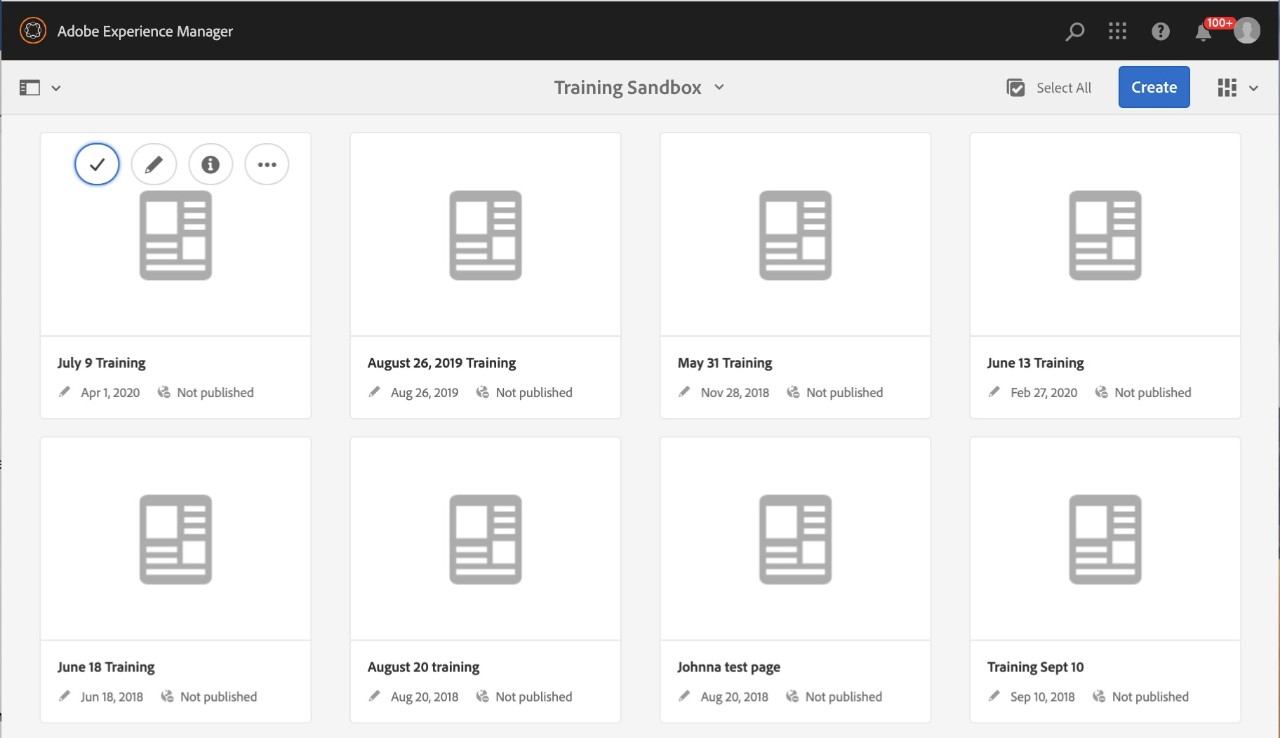Sites Console
After you log into AEM, you'll be able to see all pages and sites in AEM using the sites console. Locating your site and having a general understanding how sites and pages are organized in AEM will make completing several actions easier.

The product navigation button reads "Adobe Experience Manager" and can be found in the top left corner of the screen. It allows users to move between different sections of AEM such as sites and assets.
There are three main areas that AEM authors will use.
- Sites - Houses all pages and sites in AEM. Most of your time spent in AEM will be in sites, and most of this training will cover how to work in the sites console.
- Assets - Where images and documents are stored in order to be used on pages.
- News - All stories for UC News are created and submitted through AEM. Separate access and training is required for access to the news system.
Reminder
Anyone with an active 6+2 will have read-only access to AEM. After completing the required training, permissions will be added to your account that allow you to edit and publish the pages specific to your college and/or unit.
Switching Views
AEM comes with three different view options: column, card and list. Since the AEM Touch UI is designed to also be used with a tablet or mobile device, the different view options allow you to adjust your view dependent on the device you are using.
Column View
The column view is best suited for desktop editing and allows for a visual navigation of a pages through a series of cascading columns. Selecting a page in the leftmost column will display the child pages in a column to the right. Selecting a page in the right column will then display the child pages in another column to the right and so on.
Card View
Card view displays information cards for each page at the selected level. These provide information such as:
- A visual representation of the page content.
- The page title.
- Important dates (such as last edited, last published).
- If the page is locked or hidden.
List View
Similar to the card view, list view shows you one level of pages at a time. You can navigate down through pages by tapping/clicking on the page name and back up by using the breadcrumbs in the header.
AEM Tip
You can use the list view to re-order your pages. Hover over the small dots on the far right of each page listing. When the hand icon appears, drag and drop to adjust the order. The order your pages exist in AEM will be the order your pages are shown live on your site.
Once in column view, you will see a single column on the left-hand side of the screen. All of the pages within AEM can be found by expanding down the correct node. Once you have located your site location in AEM, you can bookmark it to easily return to your site location for your next edits.
Subdomains
Using the column view, the first column from the left will contain all subdomain sites. Subdomain sites can be easily identified by checking the URL. Any site follows the format sitename.uc.edu is a subdomain and can be found in the first column. Most colleges are examples of subdomains (cech.uc.edu, business.uc.edu, etc.)
Sites under uc.edu
The other main section users will need to navigate is the "home/uc" node. Any site that starts with uc.edu/sitename can be found under this node.
Selecting Pages in Sites Console
Since AEM is a touch system, you won't double click anything in AEM. All of the interactions have been designed to also work with touch devices, such as tablets or mobile devices. With that, there are two different ways to interact with pages.
Page Icon

The icon is the square to the left of the page name. If the page has a featured image, the thumbnail of that image will be displayed. A grey page icon will be displayed if the page doesn't have a featured image.
When selected, the square will turn blue and a cirlce with a white check mark will be displayed. Most importantly, the page toolbar will appear at the top of the frame.
Page Name

Selecting the page name rectangle to the right of the icon will expand a new column to display the next level of pages. If there are no pages below, page properties will be displayed in the expanded column. Note that the page toolbar does not appear when selecting a page this way.
The name listed on the top is the Page Title, a traditionally formatted title for the page.
The name listed below will be formatted in lower case letters with hyphens and will be recognized as the last part of the page URL.
Action Toolbar
When the page icon is selected, the action toolbar appears across the top of the frame. Many of these functions will also be available from the page properties toggle menu while editing a page.
The number of menu items shown across the top of the page is dependent on your screen size. When the menu bar is longer than the screen, the additional menu items are available via a drop down menu by tapping on the ellipsis.
AEM Tip
The functions available in the action tool are repeated in AEM in other places. Understanding these functions will help you understand other areas of AEM as well.
Create
If you have permissions to a site area, you can click the create button to create a new page that will live below the page level selected.
Edit
Select this if you want to open the page you have selected to edit. This will be one of your primary functions in AEM.
Properties
Selecting this will open the page properties window. Page properties are set when the page is first created and can be edited in the page properties window with the exception of the name field. If you need to change the name field, check out how to move a page.
Lock
We strongly recommend that you DO NOT lock any of your pages. When a page is locked it can only be unlocked by the user who locked it. There may be a significant delay in being able to edit your page if the original user cannont unlock the page.
Copy
You can copy a page and optionally all of it's subpages to a new location.
- After you click copy, the toolbar will be automatically exited.
- Navigate to the location where the copy of the page will live.
- The paste icon will be available directly to the left of the create button.
If the template of the copied page is not allowed at the location you are trying to place it, an error message will appear. However, you can create a new page with the correct template at the desired location and copy the content over.
Move
Learn about how to move a page on our advanced tips and tricks section.
Quick Publish
This will publish the selected page, pushing any changes to the pubically-visible page. A confirmation dialog box will be displayed confirming you want to publish the page. This will publish only the page selected, but does not also publish pages that live below this one.
Manage Publication
Manage publication offers more options than quick publish, allowing for the addition of child pages, options for referenced pages. Selecing this will open the manage publication wizard.
- Options: The first window asks you to choose to publish or unpublish the selected pages and also if you want to take that action now or at a later date.
- Scope: you can select an item in the list to configure its further options such as:
- Include its children.
- Remove it from the selection.
- Manage its published references
Delete
Deleting a page removes it completely out of AEM. It does not also deactivate a page. Remember to deactivate your page to remove it from the published site before deleting a page from AEM.


